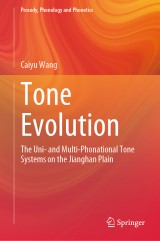Details
Tone Evolution
The Uni- and Multi-Phonational Tone Systems on the Jianghan PlainProsody, Phonology and Phonetics
|
CHF 130.00 |
|
| Verlag: | Springer |
| Format: | |
| Veröffentl.: | 22.08.2024 |
| ISBN/EAN: | 9789819700028 |
| Sprache: | englisch |
Dieses eBook enthält ein Wasserzeichen.
Beschreibungen
<div>This book provides a start of defining the uni- and multi-phonational tone systems of geographically-connected dialects under a phonation-pitch tonal model. It also demonstrates an interpretation of the contemporary ongoing tonal variations and varieties from the perspective of language evolution. Acoustic data are collected from five adjacent counties on the Jianghan Plain in China, where two varieties of Southwestern Mandarin and one variety of Gan Dialect are spoken. Falsetto and breathy phonations are applied in this area for phonological distinction, and thus the modal-only dialects co-occur with the di-phonational (falsetto and modal) and tri-phonational (falsetto, modal, and breathy) ones. The acoustic and perceptual analyses are conducted to define tones under the Multi-Register Four-Level Tonal Model, a frame considering both pitch and phonation for the definition of tones. The synchronic variations and varieties within and across speakers/dialects are interpreted in the dynamic interplay of tones mainly governed by phonetic and phonological reasons. The inner-system tonal differences of individual dialectal varieties together with the general distributive patterns of tones in this area are evaluated to determine the paths of tone evolution.</div><div><br></div><div>Fresh for it exploring the definition and linguistic meaning of the dynamic modal- and non-modal tones, the book benefits researchers with data, research methods, and insight and helps the language teachers and learners understand and learn tones with what the lexical tones really are. The book is also written for the readers curious of tones and tone languages.</div>
<div>Chapter 1 Introduction.- Chapter 2 The Jianghan Plain and the Co-occurrence of Uni- and Multi-Register Tone Systems.- Chapter 3 Songzi Dialects: Uni- and Di-register Tone Systems.- Chapter 4 Shayang: Uni- and Di-register Tone Systems.- Chapter 5 Gong’an: Changing Tone Systems.- Chapter 6 Shishou: Systems of Five to Six Tones Depending on the Moving Qingqu.- Chapter 7 Jianli: Tri-, Di-, and Uni-register Tone Systems.- Chapter 8 Definition and Evolution of the Tone Systems in Uni- and Multi-Phonational Languages Bibliography and References.</div><div><br></div>
<b>Caiyu Wang </b>received her Ph.D. in linguistics from the Hong Kong University of Science and Technology in 2015, and now, she is an associate professor of the School of Foreign Languages at the Zhongnan University of Economics and Law, China. She was a graduate researcher at the UCLA Phonetics Lab in 2013 and a visiting scholar at Penn Phonetics Laboratory in 2018. Her main research interests are of the studies of tones and tone evolution. She is the principal investigator of the Humanities and Social Science Project of the Ministry of Education of China (16YJC740066), Four to Ten Tones: The Tones and Their Evolution in Southern Hubei. Her work on the uni-phonational tone systems of modal-voice tones and the multi-phonational systems of modal and non-modal (falsetto and breathy) tones shows the panorama of complex lexical tones and is a start to explore tone evolution through the contemporary tones in a connected area.
<div>This book provides a start of defining the uni- and multi-phonational tone systems of geographically-connected dialects under a phonation-pitch tonal model. It also demonstrates an interpretation of the contemporary ongoing tonal variations and varieties from the perspective of language evolution. Acoustic data are collected from five adjacent counties on the Jianghan Plain in China, where two varieties of Southwestern Mandarin and one variety of Gan Dialect are spoken. Falsetto and breathy phonations are applied in this area for phonological distinction, and thus the modal-only dialects co-occur with the di-phonational (falsetto and modal) and tri-phonational (falsetto, modal, and breathy) ones. The acoustic and perceptual analyses are conducted to define tones under the Multi-Register Four-Level Tonal Model, a frame considering both pitch and phonation for the definition of tones. The synchronic variations and varieties within and across speakers/dialects are interpreted in the dynamic interplay of tones mainly governed by phonetic and phonological reasons. The inner-system tonal differences of individual dialectal varieties together with the general distributive patterns of tones in this area are evaluated to determine the paths of tone evolution.</div><div><br></div><div>Fresh for it exploring the definition and linguistic meaning of the dynamic modal- and non-modal tones, the book benefits researchers with data, research methods, and insight and helps the language teachers and learners understand and learn tones with what the lexical tones really are. The book is also written for the readers curious of tones and tone languages.</div>
Defines not only simple tones produced in modal voice but also compound tone systems Interprets the contemporary ongoing tone variations and varieties from the perspective of language evolution Helps the researchers to study and learners to learn tones by offering a panorama of tone types
Diese Produkte könnten Sie auch interessieren:

Language Policy and Modernity in Southeast Asia

von: Antonio L. Rappa, Lionel Wee Hock An

CHF 118.00
















